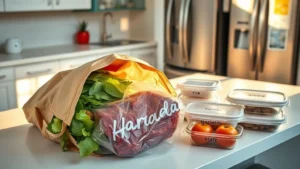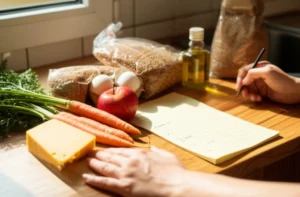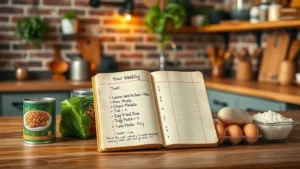Busting Money Myths
Wait…is “expensive” always better?
Let me start with a confession: for years, I thought saving money meant eating only instant noodles and skipping coffee with friends. You know that “only rich people can afford fresh food” thing? Yeah, I totally fell for it. But that’s just a myth—one I’m on a mission to bust. You don’t have to live bland or lonely to get serious about how to save money. It’s all about the everyday moves nobody writes headlines about.
Why do we believe the hype?
“Organic means healthy”, “Coupons are for people with hours of free time”, or the classic, “Only big cuts add up.” These ideas stick around because they sound simple. But the truth? Even small savings—like swapping out pre-packed salads for DIY greens—can slide $50 or more back into your pocket every month. Imagine that…
Real numbers: Store vs. DIY
| Item | Store-Bought Price | DIY/Natural Alt. | Monthly Savings |
|---|---|---|---|
| Pre-made salad | $5/meal | Home-chopped greens | $30 |
| Bottled dressing | $4/bottle | Homemade vinaigrette | $15 |
(Swear I’m not making these numbers up. Try it for a month and just watch your receipts.)
Start With a Plan
Got a food budget yet?
No guilt trips here if you don’t. But let’s get real—tracking what you spend on food for just one week can be a game changer. It’s kind of like realizing you’ve been driving with the emergency brake on—suddenly everything gets easier when you know where the slowdowns are.
Aim for something simple. There’s this basic rule: 50% for needs (groceries, rent), 30% for wants (takeout, snacks), 20% for savings. No need to get fancy. Just jot down what you already buy—pen and paper, spreadsheet, doesn’t matter.
I had a friend—let’s call him Mike—who set up an auto-transfer of $20 each week to a separate “do not touch me” account. All it took was making his own coffee. One tiny switch, and over a year? Vacation money, baby.
Budgeting, fast and dirty
- Write out your weekly meals (yes, even the late-night nachos…)
- Highlight what’s seasonal or on sale. Seasonal = natural savings, every time.
If you want to go deeper into this, I’d suggest checking out how to adapt budgeting based on your paycheck with How to save money from salary. Practical tips for all income types—really worth it if your checks are never quite the same twice.
Small Wins, Big Gains
Does buying in bulk really work?
I used to think bulk-buying meant stocking up on massive 30-pound rice sacks and hoping for the best. But, honestly, buying non-perishables or freezer-friendly foods really does save money—if you actually use what you buy (big “if”, I know!).
Here’s a story: one month, I bought giant oats, canned beans, and some beans (don’t ask how many). For weeks, I made my own breakfasts and burritos. Not only did I dodge $20 in last-minute takeout, but I kinda felt like I was beating the system. Is that weird?
Bulk vs. small — worth it?
| Bulk | Small |
|---|---|
| Cheaper per unit (but you need storage/plan for shelf life). | Less risk of waste (but costs more overall). |
| Great for basics—rice, oats, canned tomatoes, dry beans, pasta. | Good for “treat” foods—ice cream, special snacks, things that spoil fast. |
Pro tip: Don’t buy in bulk unless you know you’ll actually use it. Don’t become the person with 20 pounds of lentils collecting dust in the pantry. (Been there.)
What’s lurking in your fridge?
Have you ever peeked in, felt guilty, and just closed the door real quick? Yeah, me too. Food waste is like throwing money away, except it’s quieter (and more stinky). Little tweaks—meal prepping, freezing leftovers, using up odds-and-ends for soup—can save $100 or more a month. That’s real cash.
Sample meal prep table (real life edition):
| Day | Meal Idea | Cost per Serving | Savings Tip |
|---|---|---|---|
| Mon | Veggie stir-fry (end-of-week produce) | $2 | Use whatever’s about to expire |
| Wed | Lentil soup | $1.50 | Dry goods last forever |
If you want more clever ways to save in and out of the kitchen, I collect my oddball food tricks in 10 ways to save money. Try a few and see what fits—you don’t have to do all ten. (Who has time?)
Make Saving Feel Good
Coupons: friend or time trap?
Look—I’m not going to tell you to spend hours clipping coupons. My grandma did that, and it worked for her, but her hobby was couponing. Use apps that do the searching for you (I like Ibotta for cash back, Flipp for scanning local sales). Set alerts for stuff you’d buy anyway—don’t get lured into buying weird things just because there’s a deal.
I have a friend who started using digital coupons only for things already on her list. At the end of one year, she had an extra $300 in her account. Zero stress. Just a few clicky-clicks each week.
App Showdown:
- Ibotta: Cashback on staples (think milk, eggs, veggies).
- Flipp: Compares store flyers—no driving from store to store, promise.
Speaking of apps and quick wins—if you’re feeling tight on cash, you might want to check out How to save money fast on a low income. Some good tips for when your food budget feels…well, impossible.
Growing food at home… really?
Okay, don’t roll your eyes. You don’t need a farm—just a windowsill and some patience. A $2 basil seed packet became $50 worth of fresh herbs for me one summer (not kidding). Plus, it’s oddly satisfying to snip your own greens for a salad—makes you feel like a fancy chef, minus the French accent.
Make Habits Stick (and Grow Your Stash)
Where should the savings go?
Here’s where magic happens. Don’t just let your grocery savings blend into your checking account—move them. Automate a transfer—$10, $20, whatever you can swing—into a high-yield savings account. Even a small amount grows faster than you’d expect. I started doing this (swiping leftover lunch money into savings), and it quietly built my first-ever $500 emergency fund. That paid off HUGE when my car needed a new battery out of nowhere.
Goal setting, but the chill way
- Pick a target: $100…$250…$500… doesn’t matter. Aim for “doable.”
- Send your food savings there every pay period, even if it’s just $5. Reward yourself when you hit a milestone (invite a friend for coffee—you’ll both appreciate it).
I talk about this (and a bunch of other clever ways to save money) in the How to save Money book—lots of little stories from real, messy human beings. Spoiler: nobody sticks to their plan 100%. That’s not the point.
Final Word: It’s About Progress, Not Perfection
Alright, friend—deep breath. You’ve made it through a whole lot of ideas, charts, and likely more than a few “aha!” (or “huh?”) moments. Maybe you’re already meal prepping or maybe just now realizing how much money you toss every week without even thinking. It doesn’t matter where you start—it matters that you keep going. Your first move could be simple—bring lunch twice next week or try one new bulk buy. Maybe you actually open that savings account for grocery leftovers. Whatever you pick, don’t stress about doing it all perfectly.
Remember, every dollar you keep is a win. Track your tiny victories, celebrate when you hit a goal, and forgive the splurges—yes, dessert counts as self-care sometimes. If you want more bite-sized tips or need a nudge to start, check out the How to save Money book—it’s kind of like having me, but in your back pocket. So, what’s your first clever move? Share it—or even your worst budgeting disaster (I promise, no judgment)—below. You’ve got this. Let’s make frugality fun, friendly, and full of flavor again.












